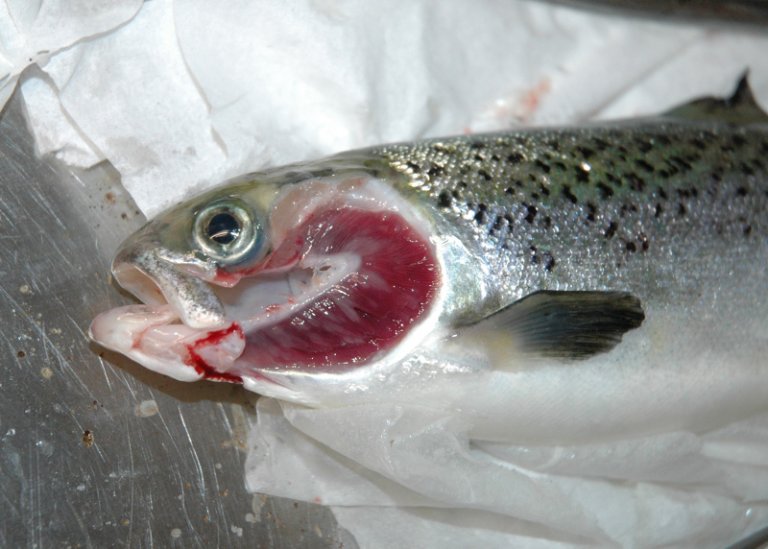
AGD is a disease affecting marine-farmed fish, primarily Atlantic salmon, but it has also been detected in other farmed species such as rainbow trout, turbot, lumpfish, and various wrasse species.
Pathogen and Transmission
AGD is caused by the parasitic amoeba Paramoeba perurans (synonym: Neoparamoeba perurans).
The amoeba exists in both parasitic and free-living stages and can survive in sediment and equipment associated with fish farming. Free-living stages may persist for several days and likely contribute to long-distance spread. Other transmission routes include the movement of infected fish and equipment, or migratory infected fish and other carrier organisms.
Clinical Signs
Fish with AGD exhibit respiratory distress, poor appetite, reduced swimming activity, and sluggish escape responses.
Lesions are restricted to the gills, often appearing as white, mucus-covered areas, although such areas can also be caused by other conditions. When AGD occurs alone, the respiratory surfaces of the gills may be fused, mucus cell activity increases, and large numbers of amoebae can be observed on the irritated tissue surface.
Diagnosis
Paramoeba perurans can be detected via microscopy of fresh gill smears. A confirmed AGD diagnosis requires histological examination and PCR testing.
Occurrence
AGD was first detected in Norway in 2006, then again in 2012, and has been confirmed annually since. The disease now occurs from Agder County northward to Nord-Trøndelag and can lead to significant losses. Fish are susceptible throughout the seawater phase, but first autumn in sea is particularly high risk. Outbreaks tend to be prolonged.
Key risk factors include high salinity (>32 ppt) and relatively high seawater temperatures. However, AGD outbreaks in Norway have occurred at salinities as low as 28 ppt and temperatures down to 5–6 °C.
AGD has caused major losses in Tasmanian salmon farming since the mid-1980s. In 2011 and 2012, AGD was among the leading causes of loss in salmon farming in Ireland and Scotland. Outbreaks have also been reported in the Orkney Islands, Shetland, Australia, and North America.
Monitoring
AGD is not a notifiable disease in Norway, and no active national surveillance program exists.
It is likely that fish health services or farmers themselves diagnose AGD without submitting samples to the Norwegian Veterinary Institute or other laboratories. Private labs may also detect P. perurans by PCR in samples from farming sites, without AGD necessarily developing. Therefore, the number of AGD cases registered by the Veterinary Institute should be considered a minimum estimate. Since 2012, AGD has been detected at 30–80 sites annually, with around 70 sites affected in 2023, most involving Atlantic salmon.
Control Measures
There are no specific measures known to prevent AGD outbreaks, but maintaining a healthy environment and robust fish stock generally helps reduce disease risk.
Early diagnosis is critical to limiting AGD impact. Gills should be routinely checked for white patches, and gill mucus should be microscopically examined for amoebae.
The most effective treatment is freshwater bathing. Hydrogen peroxide (H₂O₂) is also effective, but neither method is 100% reliable. Repeated treatments within the same production cycle are sometimes necessary. Freshwater treatment is gentler on salmon and appears more effective than hydrogen peroxide. Early treatment yields better outcomes, reducing recurrence and delaying re-infection. Therefore, monitoring amoeba presence in farmed fish is essential to detect disease early. This is typically done using PCR screening and visual gill examinations.
A dedicated scoring system for macroscopic gill lesions caused by AGD has been developed and serves as a critical tool for fish health services. However, after multiple treatments, accurate scoring can become difficult and requires considerable experience.
Since other factors or agents can cause AGD-like gill changes, confirmation via histology and PCR is essential.
